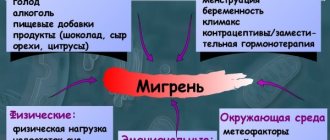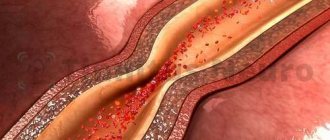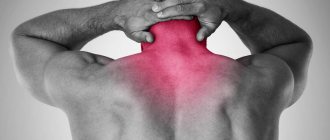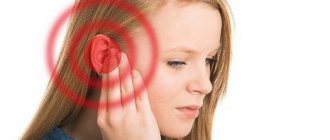Headache and ear congestion are symptoms of various diseases. They may indicate the presence of an infectious process, pathologies of the hearing aid, or vascular disorders.
Blocked ears can be caused by blockage of the ear canal with wax, and a headache can indicate fatigue. But often such sensations occur due to hemorrhage in the brain or a sharp increase in intracranial pressure. To make an accurate diagnosis, it matters where the pain is localized and whether there are accompanying symptoms, for example, a runny nose or spots before the eyes. When your ears often become blocked and your head hurts, the reasons lie in a serious illness.
Presses the back of the head, blocks the ears, dizziness
Painful sensations that are localized in the head area are considered the most insidious.
It is impossible to determine on your own what kind of pain it is: a headache or due to problems in the cervical vertebrae. Today there are many diseases, including very dangerous ones, that begin to manifest themselves with pain in the back of the head or dizziness.
Diseases of the neck and vertebrae can lead to feelings of heaviness in the head and dizziness, general weakness and sometimes nausea.
The main causes of dizziness and a feeling of tightness in the back of the head can be:
Malysheva: statistics show that more than 70% of people are, to one degree or another, infected with parasites, which can cause a person to have HEADACHES, Dizziness, Fainting, as well as more dangerous diseases, including cancer. To find out if there are PARASITES in the body, just take it.
- mental or physical stress;
- constant stress, depression. Mostly women over 25 years of age are susceptible to this condition. But men can also suffer;
- various diseases of the cervical spine;
- may occur as a result of vegetative-vascular dystonia, as well as when the pressure of the intracranial box is disturbed;
- Similar problems can arise when blood pressure is compromised. With low or significantly increased blood pressure, pain occurs in the back of the head and dizziness occurs. Most often this concerns elderly patients;
- Sometimes the causes of dizziness, weakness and pain in the back of the head can be head injuries or bruises in the neck;
- osteochondrosis of the cervical spine. In addition to compression in the back of the head, tinnitus and blurred vision may occur.
If you experience frequent dizziness, a feeling as if your head is numb and there is pressure in the back of your head, then you need to consult a specialist, as these may be symptoms of serious diseases.
If you feel pain or pressure in the back of your head, try to ventilate the room well. Open all windows if possible. Lie down on the sofa and try to completely relax, massage your neck and back of your head.
Try to calm down. If the pain was caused by stress or overexertion, then you can drink valerian, motherwort or other sedatives.
If pain or pressure in the back of the head, as well as dizziness occur quite often, you should consult a doctor. It is not recommended to prescribe medication on your own. First you need to determine the cause of such pain.
Sometimes these can be quite serious diseases that require careful diagnosis. Depending on the disease, the doctor may prescribe a course of anti-inflammatory, sedative and painkillers. Additionally, a course of massage or acupuncture may be prescribed.
If the cause of pain in the back of the head or dizziness is blood pressure, then you first need to measure it.
If you have low blood pressure, you can drink caffeinated drinks or medications. Tinctures of lemongrass, ginseng and eleutherococcus will help raise blood pressure.
If the pressure is significantly low, it is necessary to take a horizontal position; the use of any medications is not recommended. Low blood pressure contributes to dizziness and loss of consciousness.
The patient needs complete rest. If you have low blood pressure, you can drink a cup of black tea with lemon or still water. Next, consult a doctor for a diagnosis and treatment.
Additionally, it is necessary to undergo an MRI of the cervical spine and head to find out the condition of the brain vessels.
Such conditions can indicate a variety of diseases. Headaches can occur both from diseases of the vertebrae and from the presence of tumors in the brain. So, dizziness can be a symptom of the following diseases:
- atherosclerosis;
- increased blood pressure;
- diseases of the spine;
- Meniere's disease;
- hypotension (low blood pressure);
- the possible presence of tumors, both benign and malignant;
- neurological diseases (neuralgia of the occipital region)
The most common cause of such conditions is neurology. First of all, you need to contact a neurologist. The doctor will prescribe the necessary tests and studies.
In more rare cases, a patient with similar complaints is diagnosed with tumors at various stages. Surgery may be recommended here.
You should pay attention to the analysis, which determines the level of intracranial pressure. An increase or decrease in this pressure may also indicate diseases of the brain, in particular the presence of focal formations.
Experts strongly do not recommend taking medications on your own if you have symptoms of headache, weakness, dizziness or pressure in the back of the head. Such symptoms can be the first “bells” of a dangerous disease that requires immediate medical intervention.
Have you ever tried to get rid of dizziness? Judging by the fact that you are reading this article, you know firsthand what it is:
- frequent discomfort in the head area (pressing or throbbing pain).
- darkening of the eyes, noise in the ears.
- sudden feeling of weakness and fatigue, increased heart rate and sweating.
- there is nothing to say about shortness of breath after the slightest physical exertion.
Now answer the question: are you satisfied with this? Can ALL THESE SYMPTOMS be tolerated? How much time have you already wasted on ineffective treatment? After all, sooner or later the SITUATION WILL GET WORSE.
Source: https://nstone51.ru/golovokruzhenie/davit-zatylok-zakladyvaet-ushi-golovokruzhenie/
First aid
Before contacting a doctor, you can try to get rid of the symptoms yourself. To do this, the following measures are taken:
- They make swallowing movements to balance the pressure - chew gum, suck a lollipop, drink water from a straw;
- If your ears are blocked due to a runny nose, use vasoconstrictor medications;
- If the patient knows that he has hypertension, he needs to measure his blood pressure and, if necessary, take the prescribed antihypertensive drug;
- Pain syndrome can be relieved by analgesics or NSAIDs, however, they will erase the brightness of the clinic, which will complicate the diagnosis.
When asked what to do if your ears are blocked or you have a headache, the answer is the following: go to the hospital, and before going to the doctor, you can try to improve your condition at home. To do this you need:
- take painkillers (“Nise”, “Etodin Forte”);
- for a runny nose, use a drug that will get rid of mucus (“Sanorin”, “Rinozol”);
- if you have hypertension, you need to measure your blood pressure and take your medications to normalize the blood pressure (“Zocardis”, “Verapamil”);
- if the ears are stuffy or there is pain in the head due to a surge in pressure, you need to perform a series of swallowing movements that will relieve discomfort;
- You can get rid of the sulfur plug using a cotton swab, which needs to be soaked in hydrogen peroxide, or using special candles that can be purchased at the pharmacy.
Pain in the head area can contribute to ear congestion. This pattern also works in reverse. The main thing is to identify the cause in time and begin to eliminate it.
Causes of headaches in the back of the head, which is accompanied by tinnitus
A common complaint is pain in the head, especially in the occipital area. The condition may be accompanied by noise and ringing in the ears. The most common cause is overexertion or emotional stress. As a result, a spasm of blood vessels leading to the brain occurs, and blood begins to circulate poorly. But there are other reasons for the development of unpleasant symptoms.
Diseases that cause pain and noise
When unpleasant sensations arise in the head, it is difficult for the patient to determine whether the pain or tinnitus became primary. Very often, noise and ringing in the ears is accompanied by a feeling of pressure in the back of the head.
The discomfort in the back of the head may differ for different people. The nature of the pain can be aching, sharp, dull, throbbing, constant, temporary. There are also a lot of reasons why it occurs.
There are several main reasons why headaches lead to buzzing and ringing in the ears.
- Increased blood pressure
. Pain in the back of the head, congestion and noise in the ears appear, flies, dots, and sticks begin to appear before the eyes. Dizziness, nausea and even vomiting are often associated. The patient may complain of heaviness and a feeling of pressure in the sternum. The general condition deteriorates sharply, weakness appears, and numbness of the limbs is felt. - Decreased blood pressure
. At the same time, the back of the head, neck hurts, the pain is pressing. Weakness appears throughout the body, and the ears become blocked. - Vegetative-vascular dystonia
. - Heart diseases
. - Atherosclerosis of cerebral vessels
. Cholesterol formations prevent the free passage of blood through the vessels, which supplies the brain with nutrients and oxygen. Pain develops, which gradually moves from the back of the head to other areas of the head. The patient complains that there is a ringing in his ears. - Disorders affecting the venous artery
. A condition where tinnitus follows the beat of the heart. A person often has a headache, stuffy ears, nausea, and pulsation increases when changing body position. - Inflammation of the occipital nerve
. The disease often worsens with osteochondrosis or hypothermia. The pain in the back of the head is acute, radiating to the ears, cervical spine, and back. The headache gets worse with any movement, as well as with sneezing, coughing or blowing your nose. Between periods of exacerbation, the pain does not disappear, but turns into a dull, pressing form. - Increased intracranial pressure
. The whole head hurts, including the back of the head. Vision is impaired, congestion and noise in the ears are felt. You may feel dizzy and nauseous, and may be bothered by vomiting, which does not bring relief to the patient. - Osteochondrosis in the cervical spine
. The artery that carries blood to the brain is compressed, resulting in a lack of oxygen. The pain is most often in the back of the head, which is accompanied by nausea or even vomiting. When an exacerbation occurs, the patient becomes dizzy and his ears are blocked. - Migraine
. A severe headache can affect any area, including the back of the head. The ears become blocked, and sometimes there is a ringing. The condition is accompanied by nausea, weakness, loss of appetite.
Unpleasant sensations, including noise, are a consequence of pathological changes occurring in the vessels. Where it hurts more, the disorder is more pronounced. If pain and ringing in the ears increases over time, then you cannot self-medicate, you need to consult a doctor and determine why this is happening.
There are also more serious reasons why any part of the head often hurts and there is noise in the ears.
- Multiple sclerosis
has similar symptoms. A distinctive feature is a lack of coordination of movements, a feeling of weakness and numbness in the limbs. The patient may complain of tinnitus and a headache. - Tumors
affecting
the auditory nerve.
Such a disease can be suspected when the patient begins to complain that there is pressure on the back of the head, nausea, and ringing in the ears. In this case, hearing is impaired, coordination of movements becomes inaccurate. - A brain tumor
. The headache usually occurs in the morning and may be accompanied by vomiting. As it grows, noise and congestion in the ears and dizziness appear. - Meniere's disease
. With this pathology, the ears become blocked, nausea occurs, especially when changing body position, dizziness and pain. - Meningitis
. Inflammation of the membranes covering the brain. The causative agent can be both viruses and bacteria. The headache is severe, pressing, worsens in the back of the head when bending forward, there is constant noise and ringing in the ears, and body temperature rises.
These cases, without qualified assistance, sometimes even without surgical intervention, lead to death.
Temporary changes
Sometimes tinnitus and ringing can occur without other symptoms. Why is this happening:
- ear canal injury;
- inflammatory processes affecting the ears;
- entry of a foreign body into the ear canal.
Taking medications. Some antibiotics and diuretics may cause side effects. Headache, dizziness, nausea, indigestion develop, and tinnitus may appear.
Noise and ringing in the ears can cause headaches in the following cases:
- exposure to loud sounds on the hearing organs leads to temporary congestion and ringing;
- impaired blood supply to the hearing organs;
- a sharp change in body position in space (merry-go-round rides, parachute jumping, flying in an airplane) leads to temporary disturbances in the functioning of the vestibular apparatus;
- seasickness can also cause dizziness, stuffy ears, nausea and pressure on the back of the head;
- The formation of wax plugs leads to stuffy ears.
Other common reasons why discomfort occurs in the ears and the back of the head hurts include the following.
- Underdevelopment of the optic nerve. The problem lies in the modern rhythm and way of life. For constant development, it is necessary to study objects at a great distance. But a person’s gaze rests on a computer monitor or TV. The pupils are constricted and the angle of vision is small, overstraining the visual muscles occurs. Pain impulses arise that are sent to various parts of the head.
- A sedentary lifestyle leads to various pathological formations in the spine. Incorrect posture, sitting in an uncomfortable position leads to the fact that the spine experiences overstrain and the back of the head, neck, shoulders, and eyes begin to hurt.
- Cervical migraine. Severe pain in the back of the head and temples, blurred vision, decreased hearing, dizziness.
Such symptoms can be avoided if you change your lifestyle, diet, and eliminate bad habits.
Methods to combat the problem
To prevent frequent headaches and to prevent ringing and noise from interfering with your hearing, you need to undergo an examination. Only a specialist will be able to determine why the problem occurred and how to fix it. At the initial stage, you need to contact a therapist who will prescribe an X-ray of the cervical spine, a general blood test, CT and MRI.
Based on the results, it will be decided which specialist should be contacted in the future. You may need to consult a cardiologist, otolaryngologist, ophthalmologist, neurologist, or traumatologist.
https://www.youtube.com/watch?v=it63vsLpuNw
The following activities are most often prescribed.
- Drug treatment (analgesics, NSAIDs).
- Massage. You can do a light massage yourself. You need to massage your ears, move with rotational movements over the entire surface of your head, starting from the back of your head.
- Manual therapy.
- Physiotherapy (electrophoresis, magnetotherapy).
- Physiotherapy.
If other symptoms accompany the headache, you should be wary and begin a thorough examination. Only timely contact with specialists will help to avoid complications and the transition of the acute stage of the disease to a chronic form.
Source: https://GolovaBoli.ru/simptomy/zatylok/golovnaya-bol-v-zatylke-shum-v-ushax.html
Preventive measures
A very large number of diseases are accompanied by this problem. Pressure on the ears is a concomitant symptom of various processes. And a person who has encountered such a problem at least once tries by all means to avoid a repetition of the situation. Even for those who have never suffered from excessive pressure in the ears, it is useful to adhere to the general rules. Of course, it is necessary to lead a correct lifestyle. As much physical activity as possible is recommended. A healthy diet also cannot be ignored.
Giving up bad habits, such as excessive drinking and smoking, will reduce the risk of developing diseases with these symptoms. It is also worth preventing colds, because they often entail problems with the organs of this group. Hygiene is an important point. Proper and gentle cleaning of the ear canals will help keep your ears healthy.
People prone to frequent ear congestion should avoid deep-sea diving and air travel. And if you still have to fly, then at least you shouldn’t sleep on the plane.
It's better to prevent the problem in advance. But it still happens that something puts pressure on the ears from the inside. The causes and treatment will be prescribed only by an appropriate specialist. You should not self-medicate.
Headache and stuffy ears: causes, diseases, diagnosis, treatment
Headache is a common symptom of many diseases. It can occur both with fatigue and be evidence of dangerous diseases. An unpleasant symptom requires special attention when it is accompanied by blocked ears and occurs quite often, and the attacks are prolonged.
Main causes and diseases
There can be many reasons that can cause headaches and blocked ears. All of them are divided into physical, which do not require treatment, and pathological, for which treatment is necessary.
The first group includes:
- Getting water into your ears when swimming or showering.
- A sharp change in atmospheric pressure. The symptom is clearly manifested especially with a rapid decline in indicators.
- Hormonal disorders that can be caused by hormonal disorders during pregnancy or menopause.
- Stress, neuroses and depression.
Unpleasant signs that arise for these reasons do not require treatment, as they are a normal state of the body under certain circumstances.
Important information But in most cases, headaches and blocked ears indicate the presence of serious and dangerous diseases. Only a doctor can recognize the symptoms, determine the cause of their occurrence and prescribe treatment.
Among the reasons that can provoke the appearance of ear congestion and headaches are the following:
- High blood pressure. It is considered a rather dangerous condition, which is accompanied by the appearance of spots or black spots before the eyes, nausea, developing into vomiting. A throbbing pain is felt in the temples. Discomfort and a feeling of squeezing appear in the area of the heart muscle. When a set of symptoms occurs with a certain frequency, you should not delay visiting a specialist, as they indicate a pre-stroke condition. Also, overload in the form of high blood pressure causes thinning of the heart wall and increases the risk of developing heart failure.
- Osteochondrosis. Headache, blocked ears and other symptoms in the form of pain in the spine and limitations in physical activity can be caused by osteochondrosis of the cervical spine. As a result, blood circulation is disrupted, as the vessels leading to the brain are compressed. The causes of the disease are a sedentary lifestyle and excessive physical activity.
- Viruses and colds. In addition to headaches and ear congestion, symptoms include sneezing, nasal congestion, pain in muscle tissue and joints, and fever. Treatment is comprehensive, and in severe cases the use of antibiotics is required.
- Acute sinusitis. Characterized by swelling and inflammation of the nasal mucosa. The cause of the disease is various types of bacteria. Breathing through the nose worsens, resulting in oxygen deficiency. This is what leads to blocked ears. Against the background of the inflammatory process in the nasal sinuses, a headache is also observed, which intensifies when turning the head. Lack of therapy increases the risk of purulent masses entering the body, which leads to infection. Among the consequences are swelling of the membranes of the brain, meningitis, and abscess.
- Inflammation in the middle ear. When an infection that has entered the nasal cavity penetrates the ear canal, the following diseases develop: mastoiditis, acute or chronic otitis media, labyrinthitis.
- Neuroma. This is a benign neoplasm that forms on the auditory nerve. It is detected mainly in women. In addition to headaches and ear congestion, symptoms such as dizziness and nausea are observed. In addition, there is a disruption in the performance of the masticatory muscles.
- Cork. Ear wax is not a rare disease. Earwax is a necessary element that protects the ear canal from infections and bacteria that can penetrate through the ear canal into the brain. But if there is an excessive amount of it, a plug is formed that reaches the eardrum. The result is not only a headache, but also ear congestion.
- Injuries. Most often, such symptoms are observed with traumatic brain injuries and ear damage, which can occur due to frostbite, burns with acid, alkali, foreign objects, or an unsuccessful fall.
All diseases pose a threat to health, and in some cases, life. If unpleasant symptoms appear regularly, it is important to immediately consult a doctor who will conduct a comprehensive examination, establish an accurate diagnosis and prescribe a course of therapy.
First aid
When you have a headache and stuffy ears, first of all, it is important to provide first aid in a timely manner. This is due to the fact that the intensity of painful sensations can only increase.
Experts recommend taking painkillers. But the medicine will only eliminate the symptom and complicate the diagnosis process. It is also necessary to measure blood pressure. If they are elevated, take the drug prescribed by your doctor.
In the case where the cause of the symptoms is sulfur plug, you need to purchase a special product to remove them. The use of sharp objects is strictly prohibited. You can use hydrogen peroxide. It is dropped into the ear and carefully cleaned with a cotton swab.
When the nose is stuffy, vasoconstrictor drops are used. If your ears are blocked as a result of a sudden change in pressure, it is recommended to make swallowing movements or chew chewing gum.
Diagnostics
In order to establish an accurate diagnosis, the specialist prescribes a number of instrumental and laboratory diagnostic methods. First of all, tonometry and x-ray are indicated.
To identify an infectious lesion, blood tests for hormones and a general analysis are prescribed. Depending on the symptoms, the doctor may prescribe other research methods and consultation with specialists.
In cases of traumatic brain injury, the affected area is identified by magnetic resonance imaging. This method is more informative and allows for layer-by-layer scanning of tissues.
The final diagnosis is established only on the basis of all research results, after which a course of therapy is prescribed.
Treatment
Painkillers are prescribed to relieve pain. The duration of use and dosage are determined only by the attending physician. It is also recommended to eliminate stress, nervous and mental strain. Before going to bed, you need to drink herbal infusions with a calming effect and take baths with aromatic oils.
Important information When hypertension is diagnosed, the doctor prescribes certain medications that should be taken regularly, regardless of blood pressure readings.
If you are diagnosed with a cold, it is important to drink more fruit drinks and herbal infusions. If the cause of unpleasant symptoms is cephalalgia, the use of such drugs as Pentalgin, Spazmalgon, Nurofen is indicated.
For vegetative-vascular dystonia, which is also accompanied by ear congestion and headache, antidepressants and tranquilizers are prescribed. They are prescribed only by the attending physician.
Treatment of sinusitis is carried out with the help of antibiotics, vasoconstrictors and other drugs that will eliminate the symptoms.
Therapy for osteochondrosis is also carried out comprehensively using physiotherapeutic methods, medications, gymnastics and massage.
Traditional methods
When you have a headache and stuffy ears, therapy can also be carried out using traditional medicine. But they should be used only after consulting a doctor.
For sinusitis, it is recommended to boil a chicken egg and roll it in the nose and sinuses. You can also make a cotton swab, previously soaked in propolis or honey. It is installed in the nasal passage for 10-15 minutes.
In cases where headaches and ear congestion occur as a result of a cold, use herbal decoctions, for example, chamomile, rose hips, hawthorn, mint. To normalize elevated body temperature, take aspirin.
Green tea will help restore high blood pressure. But it gives only temporary results. If you have hypertension, you should consult a doctor.
Headaches accompanied by ear congestion occur for physiological reasons, but most often can indicate the presence of dangerous diseases.
If unpleasant symptoms occur regularly, it is necessary to promptly contact a specialist and undergo treatment.
As a preventive measure, it is recommended to walk more in the fresh air, play sports, and visit a doctor annually for a preventive examination.
2897 ratings
Source: https://nervy-expert.ru/golovnye-boli/bolit-golova/bolit-golova-i-zakladyvaet-ushi/
Native reasons
Diseases that were caused by a group of natural causes are distinguished by the fact that they go away very quickly on their own without outside intervention, without causing harm to health.
Such problems are usually accompanied by pressure in the area of the ears, as well as pressure inside the head. There are several reasons why the back of the head hurts and the ears are blocked:
- A sharp change in the level of pressure in the atmosphere.
- Getting water inside the ear canal, for example, while swimming in a river or pool.
- Changes in hormonal levels in sharp jumps due to the onset of pregnancy or menopause.
If the pressure in the atmosphere increases, you should not take any action; it will be enough to wait until the body adapts itself and the condition returns to normal. If moisture gets into your ears, you need to take a position that will allow the water to drain out on its own, which will help get rid of the discomfort.
Why does pain occur behind the ears and in the back of the head?
Headache, or cephalgia, is today considered the most common pathology, which can be either independent or provoked by other diseases and abnormalities in the body.
It can be localized in various areas, there will be its own provoking reasons, including behind the ears and in the back of the head. If the first symptoms of one or another pain appear, you should consult a specialist and undergo a thorough examination. If necessary, treatment and preventive therapy are carried out.
In this situation, you should not engage in independent treatment, as you can worsen your health and provoke complications.
Why does my head hurt behind my ears?
Headaches near the ears can occur for various reasons. In parallel with cephalgia, the patient may be bothered by:
1. Noise in the ears.
2. Ringing.
3. Congestion.
If unpleasant symptoms do not go away for a long time, or even worsen, you should urgently consult a specialist. To alleviate the condition, you can take a painkiller - Citramon, Spasmalgon or Copacil.
The main causes of headaches that radiate behind the ears:
1. Epidemic mumps. This disease is also called “mumps”. The pathological process provokes inflammation of the salivary glands, as a result the patient experiences swelling and pain in the ears and behind the ears.
At the same time, the patient experiences elevated body temperature and other symptoms of an infectious disease. Therapy must be carried out efficiently and in a timely manner.
Why is treatment necessary? If you ignore the disease, unpleasant and serious complications may arise.
2. Otitis. This condition involves inflammation of the middle, outer or inner ear. In such a situation, the patient is bothered by a headache that radiates behind the ears and discharge of purulent masses.
3. Lymphadenitis is an inflammation of the lymph nodes that occurs after an illness. The patient has the following symptoms: pain and tinnitus, headache.
4. Osteochondrosis. The headache is due to impaired blood flow in the cervical region. The disorder occurs due to thinning of the vertebrae of the neck. You may also experience discomfort, congestion and ringing in the ears.
5. Neuralgia. With this pathology, damage to the trigeminal nerve is diagnosed. Very often accompanied by pain in the head and ears.
6. Inflammation of the paranasal sinuses. It provokes a headache, which can radiate not only to the ears, but also to other parts.
Oral diseases can also cause discomfort. It is worth understanding that if a headache that extends behind the ears occurs once, there is no need to worry. But if the deviation is observed constantly, has accompanying symptoms and gradually intensifies, it is necessary to begin diagnosis and treatment.
Cephalgia very often occurs with a disease such as mastoiditis - an inflammatory process of an infectious nature that affects the mastoid process, located behind the ears. If treatment is refused, it can cause serious and, sometimes, irreversible consequences. It has pronounced symptoms: ringing, congestion in the ears, discharge of pus from them, fever, and others.
In order for pain, ringing, noise, and congestion in the ears to go away, it is necessary to correctly identify the provoking factors and begin treatment. To prevent unpleasant sensations from occurring again, it is necessary not only to adhere to the doctor’s recommendations, but also to carry out prevention.
Why does my head hurt in the back of my head?
The pain in the back of the head, as well as in the upper part of the neck, is very unpleasant and painful. In such a situation, the patient cannot always say what exactly hurts him - the cervical region or the head.
There are many provoking factors for unpleasant sensations in the back of the head, the main one of which is considered to be intense tension in the deep extensors of the neck, which are located lower than the back of the head.
Discomfort in the cervical spine may occur as a result of bending or slightly turning. There are situations when it is impossible even to touch a given part of the body.
Some individual headaches
Experts identify the main types of pathological conditions:
- primary – not related to other diseases (about 90%);
- secondary condition – accompanied by inflammatory effects (up to 10%)
But only about 4 percent of pain in the occipital part of the head is a sign of a severe disease that threatens not only the health, but also the life of the patient.
Pain syndrome affects different parts of the head ( the part of the animal or human body that contains the brain, organs of vision, taste, smell, hearing and mouth
): temporal, frontal, occipital and parietal.
Etiology
The causes of pulsation in the ear are very different. These include:
- Infectious and inflammatory diseases of the auditory analyzer,
- Closed and open head injuries,
- Vascular diseases - sclerosis, hypertension, various vascular malformations,
- Stress,
- Neoplasms of the head and neck,
- Wax plugs in the ears,
- Long-term healing with antibiotics, especially ototoxic ones,
- Long-term use of non-steroidal anti-inflammatory products,
- Hormonal surge during pregnancy, menopause,
- Degenerative-dystrophic configurations of the spine,
- Everyday implementation of headphones,
- Pressure surges during air travel, diving, mountain climbing,
- The natural process of aging of the body.












